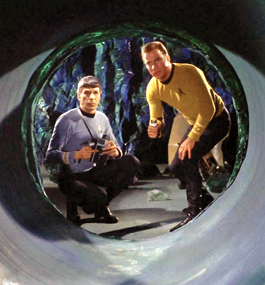‘Trek,’ Even Unto Its Innermost Parts

Courtesy Mark A. Altman
by Mark A. Altman ’88
It was 1987, but I still remember that day like it was yesterday.
Sitting behind my desk in the claustrophobic confines of The Justice’s office, in the bowels of the Usdan Student Center, I opened a press kit from Paramount Pictures. A new television series, “Star Trek: The Next Generation,” a successor to the original “Star Trek” series, was being produced under the aegis of venerable Star Trek creator Gene Roddenberry.
“The Next Generation,” however, would feature an entirely new cast and crew. No Kirk, no Spock, no Denebian slime devils. It wouldn’t even air on a network — it would appear in syndication, on a patchwork array of channels. None of this seemed particularly encouraging. As a result, Paramount was doing everything it could to attract a modicum of interest, including suggesting that journalists come to Los Angeles to visit the set.
This sounded like a delightful idea. A week or so later, I arrived in Hollywood with my photographer (aka my roommate, Mitchell Rubinstein ’88) ready to beam down to Stage 8, where the episode “Too Short a Season” was being shot. I was given access to the entire cast and crew, including an imperious Patrick Stewart (while Mitch feasted on lobster at the Paramount commissary with visual effects supervisor Rob Legato).
Nearly 30 years later, some of those first Star Trek interviews I did for The Justice — along with many, many more over the decades — serve as the nucleus for a massive two-volume tome I co-wrote, “The 50-Year Mission: The Complete, Uncensored, Unauthorized Oral History of Star Trek,” published this year by St. Martin’s Press to commemorate the 50th anniversary of the original series.
Although the first series went off the air in 1969, the 1970s were a great time to be a Star Trek fan, because a certain level of dedication was demanded. It was long before the birth of home video (the alphabet soup of VHS, DVD, Blu-ray and so on), which revolutionized the consumption of movies and TV on demand. Branded merchandise was rare. If you wanted a tribble, someone (in my case, my Aunt Gus) had to sew you one. Star Trek’s capacity to flourish was a testament both to its genius and to the enthusiasm it inspired in fans, who — long before Twitter, Facebook or Instagram — shared their Trek love in self-published ’zines and at fan-run conventions.
At Brandeis in the ’80s, I studied under the brilliant, jocular American studies professor Thomas Doherty, who nurtured my love for film and television. He introduced me to the editor of Cinefantastique magazine, who hired me over the years to write about Star Trek. I wrote stories about Star Trek for The Justice. I interviewed James Doohan (who played Scotty) when he came to speak at Brandeis.
By 1995, the Los Angeles Times had dubbed me “the world’s foremost Trekspert.” Even after I started working in Hollywood myself, my passion for Trek was undimmed. The first feature film I wrote and produced was “Free Enterprise,” a 1999 romantic comedy starring William Shatner as himself. The plot: Two die-hard Trekkies learn their idol is more screwed up than they are. (You may remember it as the movie in which Eric McCormack, of “Will and Grace,” wears a Brandeis sweatshirt.)
Before “Free Enterprise” premiered, the director and I traveled to the Cannes Film Festival with Mr. Shatner — or Bill, as he preferred to be called. It was a wonderful week. In between attending screenings, we’d walk (or, often, stagger) along the Croisette as Bill admired the beach view, muttering in his legendary staccato fashion, “Topless … topless is good.”
For me, the true magic of Star Trek wasn’t so much its optimistic (some might say Pollyannaish) view of the future. Or its prescient glimpses of technology to come (although I did dig those sliding doors and the automat-like replicators). Or even the great writing and direction, or magnificent scores. For me, the magic was William Shatner as Kirk, a man who, I’ve often said, had the respect of his crew, the loyalty of his friends, and a green girl on every planet.
Kirk is a great leader because he’s decisive and smart, yet open to others’ opinions. He’s insatiably curious. He disregards rules when necessary. He is John F. Kennedy by way of Bill Clinton. Captain Picard, on the other hand, is a different leader for a different era — the 1990s, I mean, not the 24th century — a consensus builder, thoughtful and deliberate.
Today, cynicism and fatalism are our currency, and the best TV series, from “Breaking Bad” to “Game of Thrones,” plumb man’s dark side. But when Star Trek goes into the heart of darkness, it comes out extolling the human adventure, with a palpable sense of hope for the future. And every Star Trek crew is a family, united by love for and responsibility to one another.
In the end, characters that aspire and situations that inspire are very hard to write in a palatable (and not Pollyannaish) way for a wide audience. Star Trek, to its everlasting credit, is filled with both, which is why my voyage with the franchise is still going strong.
Mark A. Altman, a film and TV writer/producer, co-wrote “The 50-Year Mission: The Complete, Uncensored, Unauthorized Oral History of Star Trek” (St. Martin’s Press, 2016). He is currently co-executive producer of the hit TNT series “The Librarians.”
